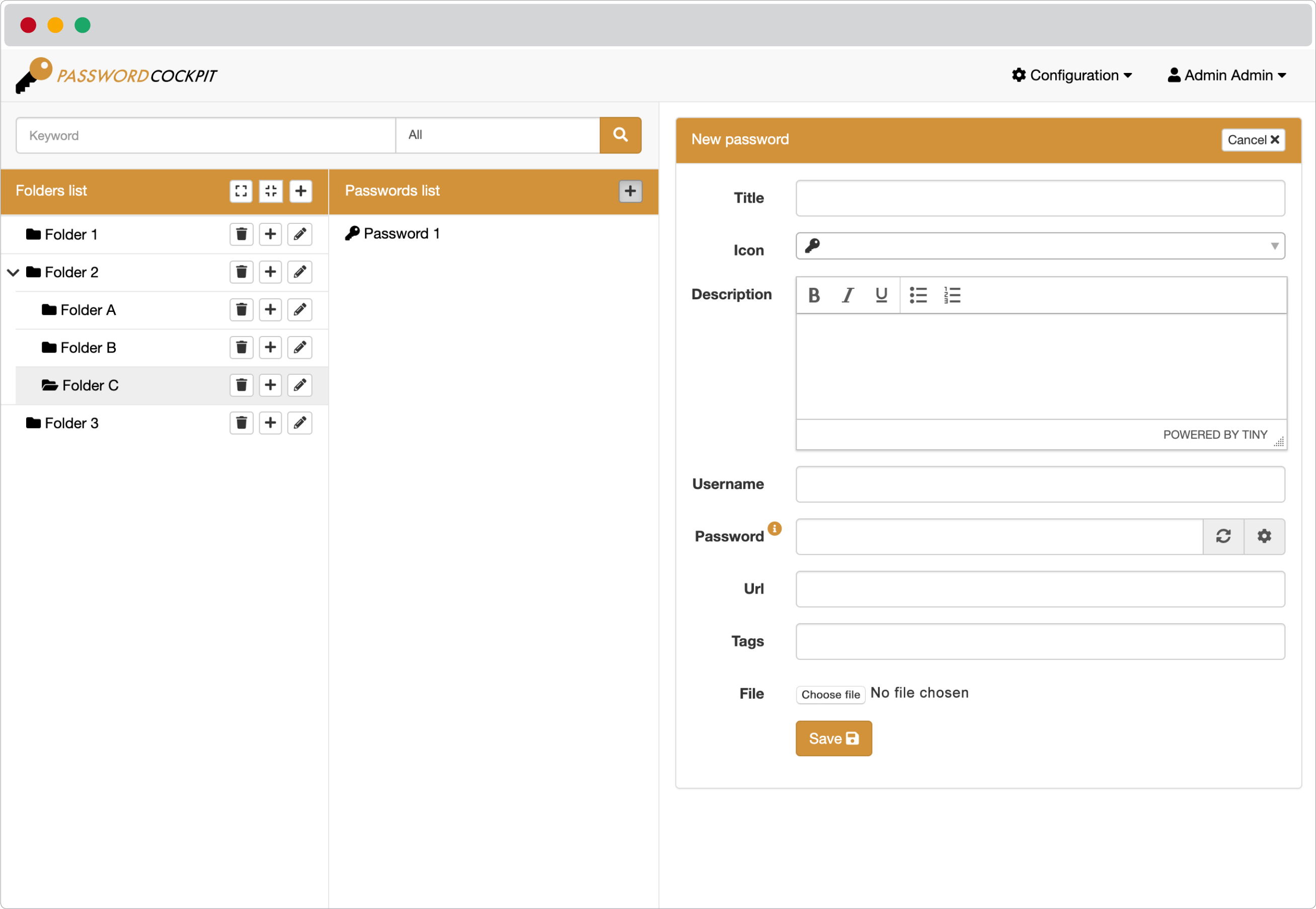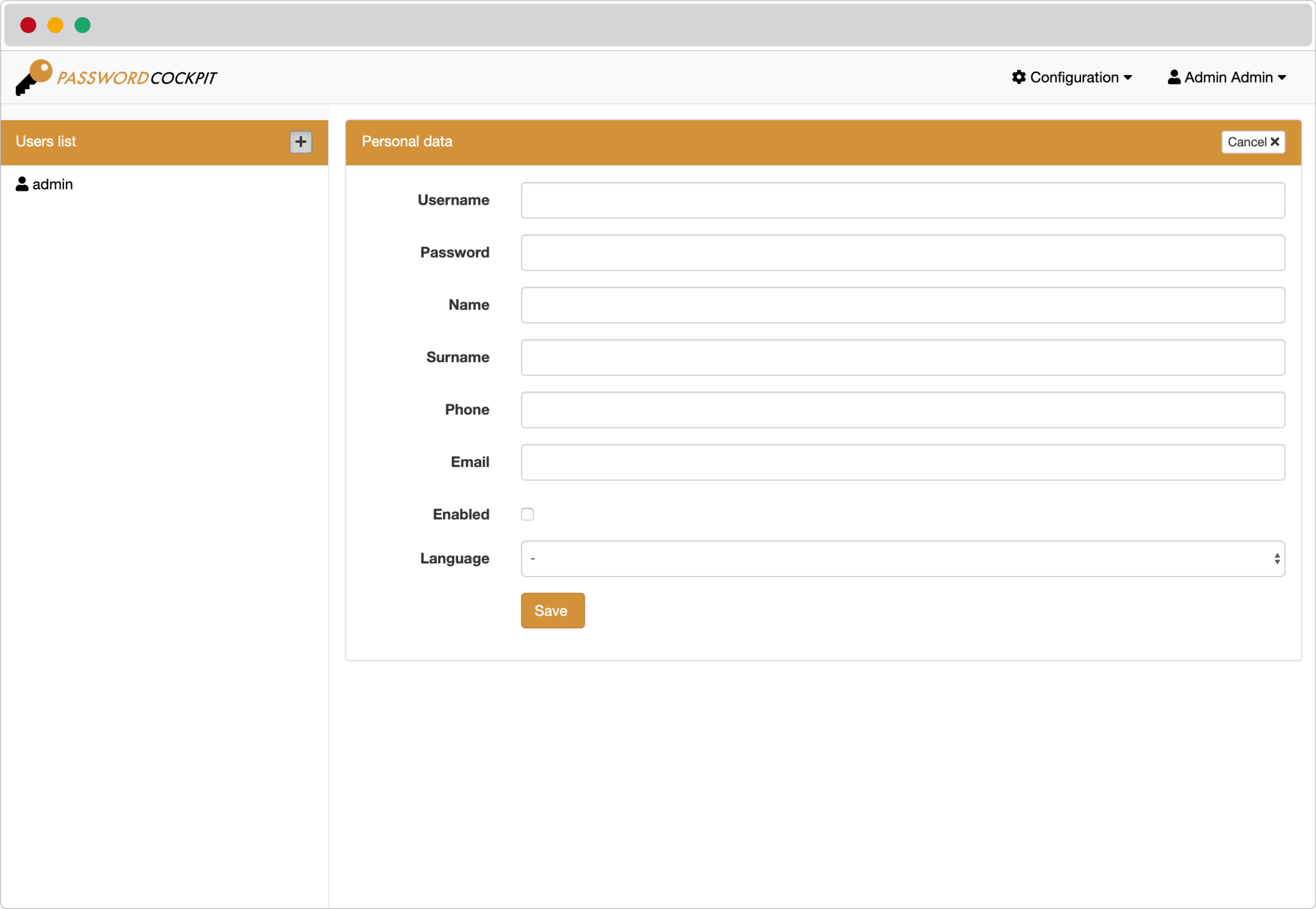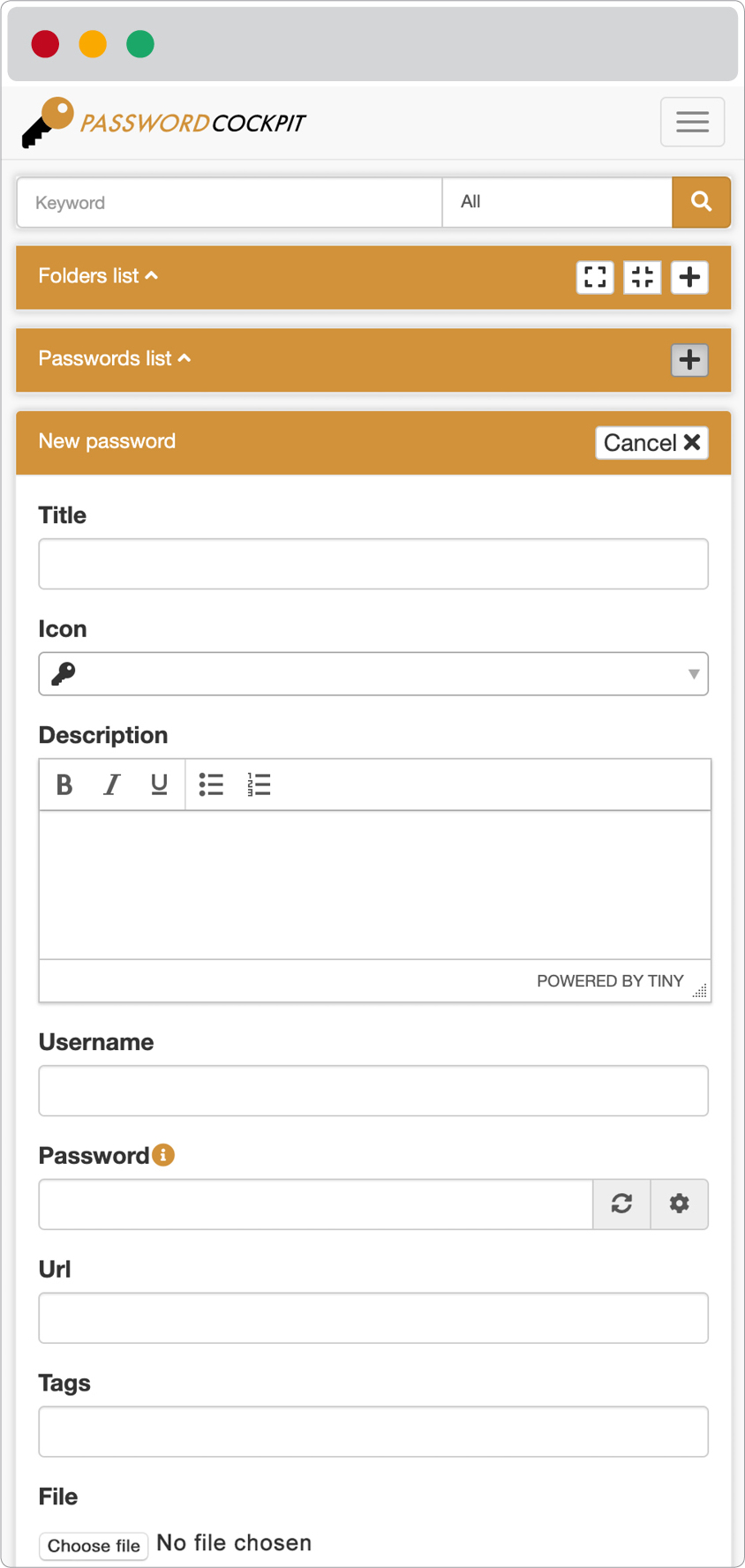https://github.com/passwordcockpit/passwordcockpit
Passwordcockpit is a simple, free, open source, self hosted, web based password manager for teams. It is made in PHP, Javascript, MySQL and it run on a docker service. It allows users with any kind of device to safely store, share and retrieve passwords, certificates, files and much more.
https://github.com/passwordcockpit/passwordcockpit
docker docker-image emberjs free laminas mezzio mysql open-source opensource password password-manager password-vault passwords php responsive restful self-hosted selfhosted web webapp
Last synced: 12 days ago
JSON representation
Passwordcockpit is a simple, free, open source, self hosted, web based password manager for teams. It is made in PHP, Javascript, MySQL and it run on a docker service. It allows users with any kind of device to safely store, share and retrieve passwords, certificates, files and much more.
- Host: GitHub
- URL: https://github.com/passwordcockpit/passwordcockpit
- Owner: passwordcockpit
- License: bsd-3-clause
- Created: 2018-12-03T12:15:00.000Z (almost 7 years ago)
- Default Branch: master
- Last Pushed: 2024-07-24T17:08:55.000Z (about 1 year ago)
- Last Synced: 2025-04-02T02:38:02.468Z (7 months ago)
- Topics: docker, docker-image, emberjs, free, laminas, mezzio, mysql, open-source, opensource, password, password-manager, password-vault, passwords, php, responsive, restful, self-hosted, selfhosted, web, webapp
- Language: Dockerfile
- Homepage: https://passwordcockpit.com
- Size: 547 KB
- Stars: 121
- Watchers: 7
- Forks: 24
- Open Issues: 8
-
Metadata Files:
- Readme: README.md
- License: LICENSE.md
Awesome Lists containing this project
README

Passwordcockpit is a simple, free, open source, self hosted, web based password manager for teams. It is made in PHP, Javascript, MySQL or MariaDB and it run on a docker service. It allows users with any kind of device to safely store, share and retrieve passwords, certificates, files and much more.



# Index
- [Index](#index)
- [Usage](#usage)
- [Permissions](#permissions)
- [Global permissions](#global-permissions)
- [Folder permissions](#folder-permissions)
- [Authentication](#authentication)
- [LDAP](#ldap)
- [Encryption](#encryption)
- [Password PIN](#password-pin)
- [Available docker configurations](#available-docker-configurations)
- [Architecture and technologies](#architecture-and-technologies)
- [Frontend](#frontend)
- [Backend](#backend)
- [Database](#database)
- [Security](#security)
- [Update to a newer version](#update-to-a-newer-version)
- [Vulnerabilities](#vulnerabilities)
- [Contribute](#contribute)
- [Screenshots](#screenshots)
- [Passwords manager](#passwords-manager)
- [Users manager](#users-manager)
- [Mobile design](#mobile-design)
# Usage
Installation is done with `docker-compose`. Please check out the [official install instructions](https://docs.docker.com/compose/install/) for more information.
Passwordcockpit docker images are provided within [its Docker Hub organization](https://hub.docker.com/u/passwordcockpit).
To start, just copy [`docker-compose.yml`](https://github.com/passwordcockpit/passwordcockpit/blob/master/docker-compose.yml) to a folder and setup the configuration as shown in the "Available docker configurations" chapter. Finally run `docker-compose up` from terminal.
When the service is up, navigate to `PASSWORDCOCKPIT_BASEHOST` (e.g. `https://passwordcockpit.com`) and login.
The default username is `admin`. The system generate the default password: `Admin123!`, this can be overridden by specifying the `PASSWORDCOCKPIT_ADMIN_PASSWORD` variable.
# Permissions
## Global permissions
Each user can have following permissions:
⚫️ Nothing (a normal user)
👥 Create and manage users
📁 Create folders
🗄 Access to all directories
📊 Can view log
## Folder permissions
Each folder has a list of associated users with their permissions:
⛔️ No access (A user cannot access a folder to which is not assigned)
👁 Read (A user can read the passwords from a folder to which he is associated)
✏️ Manage (The user can add, modify and delete passwords inside the folder)
Users can be associated to a folder even if they do not have permission from the parent folder.
# Authentication
Authentication can be done with database stored password or LDAP.
## LDAP
To use LDAP, users must exist in Passwordcockpit. The match of `PASSWORDCOCKPIT_LDAP_ACCOUNTFILTERFORMAT` is done with the username.
When LDAP is enabled it is no longer possible to modify the profile data, since they will be synchronized at each login.
# Encryption
There are 3 levels of encryption:
- Password PIN
- SSL encryption for transfering data to the server
- Database encryption for login informations, passwords and files.
## Password PIN
A password can be crypted with a personal PIN in order to hide it from users with "Access to all directiories" permission and from users assigned to the same directory.
# Available docker configurations
| Container volume | Description | Example |
| -------------------------------------- | ------------------------------------------------------------------------------------------------------------------------------------------------------------------------------------------------------------------------------------------------------------------------------------------------- | - |
| `/var/www/html/upload` | Contains passwords attached files. It is important to map for making data persistent. Access permissions of the host directory have to be the same as the user who runs docker. | `./volumes/upload` |
| `/etc/ssl/certs/passwordcockpit.crt` | SSL certificate file for HTTPS, used to overwrite the self-signed auto generated file. **IMPORTANT: specify read-only to avoid the overwrite of your certificate by the container certificate** | `./volumes/ssl_certificate/passwordcockpit.crt:/etc/ssl/certs/passwordcockpit.crt:ro` |
| `/etc/ssl/certs/passwordcockpit.key` | SSL certificate key file for HTTPS, used to overwrite the self-signed auto generated file. **IMPORTANT: specify read-only to avoid the overwrite of your certificate by the container certificate** | `./volumes/ssl_certificate/passwordcockpit.key:/etc/ssl/certs/passwordcockpit.key:ro` |
| Environment variable | Description | Example |
| ------------------------------------------- | ------------------------------------------------------------------------------------------------------------------------------------------------------------------------------------------------------------------------------------------------------------------------------------------------------------- | ------------------------------------ |
| `PASSWORDCOCKPIT_DEBUG` | Enable debugging mode, default value `false` | `true`
| `PASSWORDCOCKPIT_DATABASE_USERNAME` | Username for the database | `username` |
| `PASSWORDCOCKPIT_DATABASE_PASSWORD` | Password for the database | `password` |
| `PASSWORDCOCKPIT_DATABASE_HOSTNAME` | Hostname of the database server | `mysql` |
| `PASSWORDCOCKPIT_DATABASE_DATABASE` | Name of the database | `passwordcockpit` |
| `PASSWORDCOCKPIT_BLOCK_CIPHER_KEY` | Key for passwords and files encryption. **IMPORTANT: do not lose this key, without it you will not be able to decrypt passwords and files** | `Q7EeZaHdMV7PMBGrNRre27MFXLEKqMAS` |
| `PASSWORDCOCKPIT_AUTHENTICATION_SECRET_KEY` | Key for encrypting JSON Web Tokens | `zfYKN7Z8XW8McgKaSD2uSNmQQ9dPmgTz` |
| `PASSWORDCOCKPIT_BASEHOST` | Base host of the Passwordcockpit service | `https://passwordcockpit.com` |
| `PASSWORDCOCKPIT_SWAGGER` | Enable swagger documentation, possible values: `enable` or `disable`. If enabled, documentation can be seen here: `PASSWORDCOCKPIT_BASEHOST/swagger/index.html` | `enable` |
| `PASSWORDCOCKPIT_SSL` | Enable SSL, possible values: `enable` or `disable`. If enabled the port **4343** will be used, the system will generate a self-signed certificate that can be replaced with the one specified in the volumes configuration. If disabled the port **8080** will be used. **Standard ports 80 and 443 are no longer used because the container runs with a non-root user.**
**Since it is a SPA if you use HTTPS the certificates must be valid or you must add a security exception to your browser.** | `enable` |
| `PASSWORDCOCKPIT_SSL_RELAXED_IP` | When `PASSWORDCOCKPIT_SSL` is disabled, it can be set hosts where secure rule is relaxed. | `10.0.0.1,10.0.0.2` |
| `PASSWORDCOCKPIT_ADMIN_PASSWORD` | Admin password to log into passwordcockpit | `Password123!` |
| `PASSWORDCOCKPIT_AUTHENTICATION_TYPE` | Type of the authentication, possible values: `ldap` or `password` | `password` |
| `APACHE_RUN_USER` | For running the Apache variants as an arbitrary user. | `1000` |
| `APACHE_RUN_GROUP` | For running the Apache variants as an arbitrary group. | `1000` |
| `PASSWORDCOCKPIT_UPLOAD_ACCEPTED_MIMETYPES` | Specify accepted mime types to check when uploading a file, default value `'pdf'`. Some extensions like `yml` are detected as `text/plain` mimetype, to accept these files you are forced to add the `txt` extension | `pdf, zip, doc` |
| LDAP variables (only necessary if LDAP is enabled) | Description | Example |
| -------------------------------------------------- | ---------------------------------------------------------- | ---------------------------------------------------------------- |
| `PASSWORDCOCKPIT_LDAP_HOST` | Hostname of the LDAP server | `ldap` |
| `PASSWORDCOCKPIT_LDAP_PORT` | Port of the LDAP server | `389` |
| `PASSWORDCOCKPIT_LDAP_USERNAME` | Username for LDAP | `uid=name,cn=users,dc=passwordcockpit,dc=com` |
| `PASSWORDCOCKPIT_LDAP_PASSWORD` | Password for LDAP | `password` |
| `PASSWORDCOCKPIT_LDAP_BASEDN` | Base DN | `cn=users,dc=passwordcockpit,dc=com` |
| `PASSWORDCOCKPIT_LDAP_ACCOUNTFILTERFORMAT` | Filter to retrieve accounts, it match the `username` | `(&(memberOf=cn=group_name,cn=groups,dc=passwordcockpit,dc=com)(uid=%s))` |
| `PASSWORDCOCKPIT_LDAP_BINDREQUIRESDN` | Bind if DN is required, possible values: `'true'` or `'false'`, default value: `'false'` | `'true'` |
| `PASSWORDCOCKPIT_LDAP_USESTARTTLS` | Whether or not the LDAP client should use TLS (aka SSLv2) encrypted transport, possible values: `'true'` or `'false'`, default value: `'false'` | `'false'` |
| `PASSWORDCOCKPIT_LDAP_USESSL` | Whether or not the LDAP client should use SSL encrypted transport, possible values: `'true'` or `'false'`, default value: `'false'` | `'false'` |
| `PASSWORDCOCKPIT_LDAP_USER_ATTR_UNIQUE_IDENTIFIER` | Configure user identifier attribute, default value: `'uid'` |`'uid'` |
| `PASSWORDCOCKPIT_LDAP_USER_ATTR_NAME` | Configure name of user attribute, default value: `'givenname'` |`'givenname'` |
| `PASSWORDCOCKPIT_LDAP_USER_ATTR_SURNAME` | Configure surname of user attribute, default value: `'sn'` |`'sn'` |
| `PASSWORDCOCKPIT_LDAP_USER_ATTR_MAIL` | Configure mail's user attribute, default value: `'mail'` |`'mail'` |
| `PASSWORDCOCKPIT_LDAP_USER_ATTR_PHONE` | Configure phone's user attribute, default value: `null` | |
# Available translations
Password cockpit is translated into:
- English
- Italiano
- Français
- Deutsch
# Architecture and technologies

The application itself follows the RESTful architecture.
To ease deployment into production, frontend and backend have been built and merged in a single docker image.
## Frontend
The frontend is maintained on [passwordcockpit/frontend](https://github.com/passwordcockpit/frontend).
Frontend has been developed using [`Ember.js`](https://emberjs.com/) and [`Bootstrap`](https://getbootstrap.com/).
The PIN password encryption is made with [`Stanford Javascritp Crypto Library`](https://github.com/bitwiseshiftleft/sjcl), using AES-CCM.
## Backend
The backend is maintained on [passwordcockpit/backend](https://github.com/passwordcockpit/backend).
The server side application logic is based on PHP Standard Recommendation (PSR) using [`Mezzio`](https://docs.mezzio.dev/mezzio/), [`Laminas Components`](https://docs.laminas.dev/components/) and [`Doctrine`](https://www.doctrine-project.org/).
HAL is used as a JSON specification to give a consistent and easy way to hyperlink between resources.
Login information are stored using `Bcrypt`.
Password entitites and files are crypted with [`laminas-crypt`](https://docs.laminas.dev/laminas-crypt/), using sha-256.
User sessions are handled with [`JWT tokens`](https://jwt.io/), encrypted with HS256.
All listed encryptions are customizable with a custom key, adding cryptographic salt to hashes to mitigate rainbow tables.
All API are documented with [`Swagger`](https://swagger.io/).
## Database
Database uses [`mysql`](https://www.mysql.com) or [`mariaDB`](https://mariadb.org)
# Security
To ensure the security to your Passwordcockpit instance:
- Enable SSL (https) or put the service behind a reverseproxy with SSL.
- Set your `PASSWORDCOCKPIT_BLOCK_CIPHER_KEY` and `PASSWORDCOCKPIT_AUTHENTICATION_SECRET_KEY`.
- Set your `PASSWORDCOCKPIT_ADMIN_PASSWORD`.
- Disable Swagger.
The container runs as www-data user (non-root).
# Update to a newer version
Updating is done by pulling the new image, throwing away the old container and starting the new one.
Before performing an update, it is best to back up the database and persistent files. This will ensure that you have a copy of your data in case something goes wrong during the update process.
# Vulnerabilities
If you find any vulnerability within the project, you are welcome to drop us a private message to: security@passwordcockpit.com. Thanks!
# Contribute
[`Here`](https://github.com/passwordcockpit/passwordcockpit/blob/master/develop/README.md) you can find the steps to prepare the development environment.
# Screenshots
## Passwords manager

## Users manager

## Mobile design
